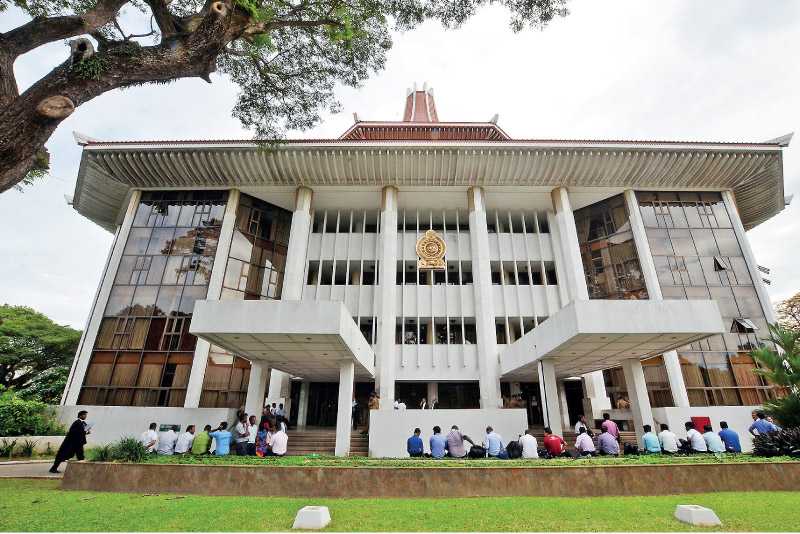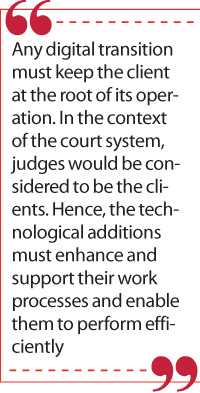Friday Apr 18, 2025
Friday Apr 18, 2025
Wednesday, 31 March 2021 00:41 - - {{hitsCtrl.values.hits}}

In Sri Lanka, the COVID-19 pandemic heightened the existing challenges and shortcomings of the legal system. As courts were closed for months, overcrowded prisons and continuous restrictions further delayed the process of delivering justice, and these limitations compounded the pre-pandemic backlog of over 750,000 pending cases. Therefore, it is prudent to consider the possibilities of rearranging infrastructure and adapting to the use of technology that offers viable solutions to the indispensable issues that litigants, lawyers and judges face today in Sri Lanka – Pic by Shehan Gunasekara
 Technology continues to permeate all aspects of the modern world. Legal systems too are transitioning from legacy IT systems to digital technologies thus redefining the ways in which justice is delivered. This article explores the possibility and feasibility of digitisation (the conversion of non-digital to digital) towards digitalisation (transitioning system operations, interactions, etc. to a digital platform) and finally towards digital transformation (the integration of technology into all aspects of a system thus creating a fundamental change or modification in the operation and model of the system).
Technology continues to permeate all aspects of the modern world. Legal systems too are transitioning from legacy IT systems to digital technologies thus redefining the ways in which justice is delivered. This article explores the possibility and feasibility of digitisation (the conversion of non-digital to digital) towards digitalisation (transitioning system operations, interactions, etc. to a digital platform) and finally towards digital transformation (the integration of technology into all aspects of a system thus creating a fundamental change or modification in the operation and model of the system).
In the face of COVID-19, court systems around the world have adapted to assist litigants better and provide greater access to justice. Both the Singapore State Courts and Philippines Supreme Court were at the forefront of providing online services and guidance to court users1 while the Court of the City of Buenos Aires in Argentina2 upscaled their audio and video capabilities to allow for virtual hearings.
Similarly, countries such as Canada were forging the path towards court systems merging both technological and human efficiency with the Civil Resolution Tribunal (CRT) in British Columbia. The CRT was established to deal with disputes relating to strata, subsidised housing and offers the Solution Explorer, with free public legal information and calculation aids, available 24/7. There are guided pathways, interactive questions and answers, dispute resolution or preparation for proceedings at CRT which is continually updated by human experts based on user feedback and analytical data about the system.3
In the United Kingdom, Lord Justice Briggs4, advocated for a digitisation of the court system that is still ongoing and has posed a plethora of challenges and positive results. The project proved to be initially expensive, but the progress continues with Wi-Fi access to court rooms, digitalised evidence and electronic filing. However, due to limited resources as well as other shortcomings, not all court systems responded actively to the challenges posed by COVID-19.
Challenges and shortcomings of SL legal system
In Sri Lanka, the COVID-19 pandemic heightened the existing challenges and shortcomings of the legal system. As courts were closed for months, overcrowded prisons and continuous restrictions further delayed the process of delivering justice, and these limitations compounded the pre-pandemic backlog of over 750,000 pending cases.5 Therefore, it is prudent to consider the possibilities of rearranging infrastructure and adapting to the use of technology that offers viable solutions to the indispensable issues that litigants, lawyers and judges face today in Sri Lanka.
While the Sri Lankan law has in the last two decades considered and reformed existing laws in keeping with the constant evolution of technology, there is still much to be desired.6 The Evidence (Special Provisions) Act No 14 of 1998 recognises two types of evidence – computer evidence and contemporaneous audio and video evidence.
The Payment and Settlement Systems Act No. 28 of 2005 laid down the procedure for the payment of cheques electronically presented while the Computer Act of 2007 was introduced to deal with social media and computer crimes. The Data Protection Act which is envisaged must be the core for the protection of data. Furthermore, it is also possible for a petitioner to file a Fundamental Rights petition through the Supreme Court website.
The advancement of technology used in the justice system was also noted in e-filing of written-submissions in the Court of Appeal and the apex court which was introduced for the convenience of the litigants during the COVID-19 pandemic. Nevertheless, in comparison to the strides taken by other court systems, there are a number of different aspects the Sri Lankan legal system needs to consider in the journey towards digital transformation.
 Costs of digitalisation and the digital divide
Costs of digitalisation and the digital divide
The first that merits consideration are the costs of digitalisation and the digital divide. For context, the UK legal system implemented a £700 million modernisation plan. In the technological reconstruction of the courts system, the cost of digitalisation and the digital divide are paramount considerations. One key factor to consider is the development of client systems, namely, whether existing IT devices provided by the courts are compatible with newer systems, and if not, whether they are capable of being processed or outsourced.
Developer responsibility must be ensured when selecting the right servers for the purposes of the justice system: one must consider the different options such as an in-house supplied server or a cloud-based storage option hosted by a special facility called an Internet Data Centre (IDC). The IDC will function as the central (virtual) host of IT equipment and operation.
Under the direction of the Ministry of Justice, the selection process would benefit from including and encouraging the involvement of younger members of the Judiciary who can bring a vibrant and fresh perspective to the integration of technology and law, and its future in the judicial system. Choosing an IDC will result in a service provider charging a rental fee for the system. Hence, the physical access, upgrading, accountability and maintenance of the system will be the responsibility of that service provider.
Court systems must additionally include a client network server HTTPS (Hypertext Transfer Protocol Secure). This protocol allows encrypted HTTP data to be transferred over a secure connection thus providing security for data over public networks such as Wi-Fi and general internet (www). Selecting an internal model would also require a sizeable capital investment for infrastructure, management tools, operating systems, operating network hardware, computing hardware and infrastructure including backup systems, HVAC systems, physical security, fire suppression, seismic proof and waterproof systems.
In order to ensure 24/7 accessibility, attention and investment must also be directed towards strategies for disaster management recovery and terrorist attacks such as the 1996 Central Bank explosion. Off-site data backups would thus provide the highest security to ensure safety and availability of the system during emergencies. However, the original data as well as backups must be secure and protected.
Data protection
Data protection should be at the heart of service contracts, and service providers must ensure the protection of Personal Identifiable Information (PII). PII refers to data which can be used to identify, locate, or contact an individual and includes information like name, date of birth, place of residence, phone number, race, gender, biometrics which have facial or voice recognition, etc. It is vital to draft such contracts and policies with reference to the CIA Triad (Confidentiality, Integrity and Availability). This is a security model used to identify problem areas and the necessary solutions in the arena of information security.
The preservation and the integrity of the court records and process (e.g. to prevent the hacking of case management systems) and protection of the individuals involved in court proceedings are dependent on the ability to keep sensitive data private. Agreements and policies must be drafted to ensure a zero occurrence of violation as a breach of such a contract cannot be prima facie a possibility. It is imperative that CIA is strictly adhered to during the drafting stage of contractual agreements. Violations of such agreements would result in the company facing financial penalties or being blacklisted.
While internal IDCs which are controlled by engineers within the internal system have proven to be a more secure option they have also proven to be a more costly alternative for a developing country with the onset of the COVID-19 pandemic. The finalisation of the software must be followed by selecting the appropriate hosting service- either through a third party or an internal hosting option which can also be more costly. While these essential considerations towards digital transformation are important, it is also necessary to review the process of doing so.
 Updating, upgrading and maintaining
Updating, upgrading and maintaining
Installation is the first step towards a digital justice system. Technology has to be constantly updated, upgraded and maintained in order to meet the apex of efficiency. Thus, the maintenance and management of such technology must be handled by a specialised team that comprises of both internal and outsourced specialists. Maintaining continuity of operations and ensuring electronic and other court data have robust backups, control over data storage, etc. are a few of the factors that require consistent monitoring.
An internal technical support service or IT support/ help desk will have the capacity to extend to Level 0 (Providing user-retrievable information, self-help service desks) and Level 1 (low level troubleshooting and technical assistance) troubleshooting issues and must be available on a 24/7 basis. A level 2 (in-depth troubleshooting, technical analysis) or Level 3 (supports the expert level of the Technical Management Function)7 solution requiring expertise solution could be passed on to the development team or the IT company or developer.
In the context of the current pandemic, incorporating automated solutions (e.g. bots) to provide support for certain level 0 issues such as password resets, etc. will minimise costs in addition to reducing human contact. However, delegation of technological support responsibilities should be strategised at the design stage and must ensure how/where/ when are these solutions available to ensure the highest level of efficiency and availability.
Better understanding and improving the efficiency of a system can be understood through two indicators such as MTTR (Mean Time to Repair) and MTBF (Mean Time between Failure). MTBF is a metric that concerns the average time elapsed between a failure and the next time it occurs. Therefore, in the proposal stage, attention should be drawn to the availability time to repair. The five-nines reliability refers to the standard often quoted for a traditional telephone service while the more “9s” of availability will affect the more time that servers will be performing throughout the year. This in turn will result in a solution that is both high quality and expensive. Communicating the requirements of the justice system in terms of availability must be done considering both transparency and cost. The needs of the judges and litigants must be emphasised when deciding on long term solutions as these factors will contribute to the public’s confidence and trust in the court systems.
Empowering judges
Any digital transition must keep the client at the root of its operation. In the context of the court system, judges would be considered to be the clients. Hence, the technological additions must enhance and support their work processes and enable them to perform efficiently.
In Austria, a pilot project to advance the justice system through technological innovations progressed over the last year and includes recommendations to equip judges with multi-touch tablets as well as touchscreen monitors and a signature pad to navigate systems easily and study files. Further, PDF file creation and electronic delivery of paper documents prevent file delays when waiting for the receipt of documents.8
Judges must also be involved in the initial design and implementation process. When the first electronic proceedings before the British Columbia (Canada) Court of Appeal were introduced, each of the five judges on the e-Appeal working group were included in the planning stage of the project with their workspaces already organised to suit their technological needs and preferences.9 The initiative found that widening the scope of stakeholders (especially the Judiciary) in the planning and implementation process was essential to creating a system of optimum efficiency.10
Footnotes
1 https://www.asia-pacific.undp.org/content/rbap/en/home/blog/2020/a-_new-possible_-for-justice-aftercovid19--towards-digital--ope.html
2 https://apolitical.co/en/solution_article/keeping-justice-alive-during-the-pandemic
3 https://civilresolutionbc.ca/
4 https://www.lexisnexis.co.uk/research-and-reports/bar/digitisation-of-the-courts-bad-news-foradvocates.html
5 lk.undp.org/content/srilanka/en/home/presscenter/articles/2020/Upholding-the-Rule-of-Law-in-SriLanka-during-lockdown-and-beyond.html
6 https://www.sundayobserver.lk/2020/09/20/impact/importance-digitalising-court-procedure
7 https://mobisoftinfotech.com/resources/blog/it-support-levels-0-to-4/
8 https://www.oecd-ilibrary.org/sites/40c8c1fb-en/index.html?itemId=/content/component/40c8c1fb-en
9 https://www.oecd-ilibrary.org/sites/40c8c1fb-en/index.html?itemId=/content/component/40c8c1fb-en
10 Lupo, G. and J. Bailey (2014), “Designing and implementing ejustice systems: Some lessons learned from EU and Canadian examples”
(The writer is Consultant, Sri Lanka Judges’ Institute. Retired Judge of the Supreme Court of Sri Lanka. National and International Arbitrator. Research assisted by Purnima Pilapitiya.)
Discover Kapruka, the leading online shopping platform in Sri Lanka, where you can conveniently send Gifts and Flowers to your loved ones for any event including Valentine ’s Day. Explore a wide range of popular Shopping Categories on Kapruka, including Toys, Groceries, Electronics, Birthday Cakes, Fruits, Chocolates, Flower Bouquets, Clothing, Watches, Lingerie, Gift Sets and Jewellery. Also if you’re interested in selling with Kapruka, Partner Central by Kapruka is the best solution to start with. Moreover, through Kapruka Global Shop, you can also enjoy the convenience of purchasing products from renowned platforms like Amazon and eBay and have them delivered to Sri Lanka.
Discover Kapruka, the leading online shopping platform in Sri Lanka, where you can conveniently send Gifts and Flowers to your loved ones for any event including Valentine ’s Day. Explore a wide range of popular Shopping Categories on Kapruka, including Toys, Groceries, Electronics, Birthday Cakes, Fruits, Chocolates, Flower Bouquets, Clothing, Watches, Lingerie, Gift Sets and Jewellery. Also if you’re interested in selling with Kapruka, Partner Central by Kapruka is the best solution to start with. Moreover, through Kapruka Global Shop, you can also enjoy the convenience of purchasing products from renowned platforms like Amazon and eBay and have them delivered to Sri Lanka.